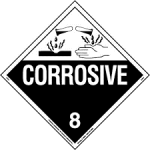When is a Class 8 Corrosive Material Not Corrosive?
By: Joe McCarthy, Lab Service Manager/Senior Regulatory Affairs Specialist, email
When it is only corrosive to one of aluminum or steel?
Imagine not having to ship your product as a Hazardous Material. Often overlooked in the Hazardous Materials Regulations are the Exceptions for Class 8 (Corrosive Materials) 49CFR173.154.
Under 49CFR173.154(d) if the material is not included in any other hazard class, is not a hazardous waste, is not a marine pollutant, is not corrosive to skin, and is corrosive to only one of aluminum or steel but not both, then it exempt from the Hazardous Materials Regulations under the following conditions:
1) If corrosive only to Aluminum, when transported by motor vehicle or rail car in a packaging constructed of materials that will not react dangerously with or be degraded by the corrosive material
2) If corrosive only to Steel, when transported by motor vehicle or rail car in a bulk packaging constructed of materials that will not react dangerously with or be degraded by the corrosive material.
If you have included a material in Class 8 by weight-of-evidence due to metals corrosion alone, it may be worth your while to test and confirm the corrosion to both Aluminum and Steel via UN TDG Test C.1 – Corrosion to metals.
Learn more about Dell Tech’s chemical lab testing services, including Corrosion to Metals Testing.





